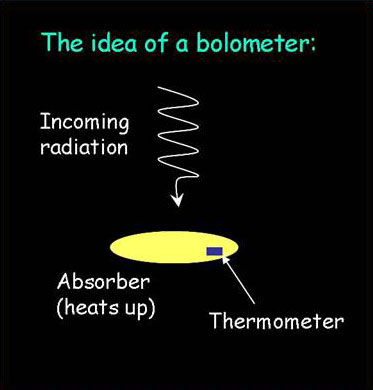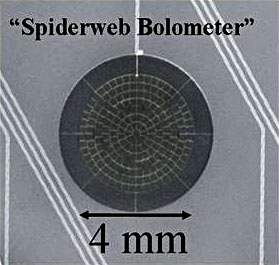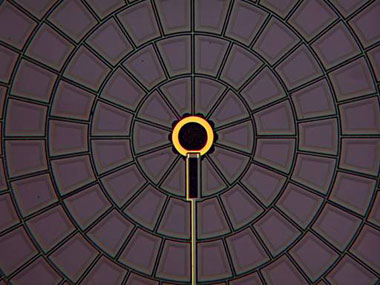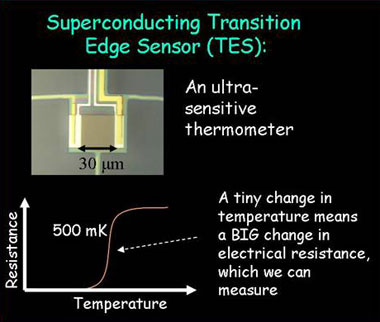|
|
 DETECTORS DETECTORS
Cosmic Microwave Background (CMB) light is collected by the South Pole Telescope's 10-meter "primary mirror". It is then reflected to the 1-meter "secondary mirror" before traveling into the "receiver cryostat", a vessel that holds the SPT detectors at a temperature less than half a degree above absolute zero. The array of detectors that makes up the receiver is something like the CCD chip in a digital camera: it consists of a large number of individual pixels, each detecting the amount of CMB light that has been received at that particular location in the array.
|
| |
 | BOLOMETERS |
|
 |
|
| |
 The detectors are not like those in a regular camera, but are instead sensitive to light with longer wavelengths. The SPT detectors are called "bolometers", which is a general term for a device that registers the amount of heat that is generated when radiation is absorbed. The radiation hits an absorbing surface and heats up that surface (the same way that sunlight heats up blacktop pavement, for example), and a sensitive thermometer reads out how much the temperature has changed. This temperature change causes an electronic signal, which is used to determine the change in the amount of radiation falling on the detector.
The detectors are not like those in a regular camera, but are instead sensitive to light with longer wavelengths. The SPT detectors are called "bolometers", which is a general term for a device that registers the amount of heat that is generated when radiation is absorbed. The radiation hits an absorbing surface and heats up that surface (the same way that sunlight heats up blacktop pavement, for example), and a sensitive thermometer reads out how much the temperature has changed. This temperature change causes an electronic signal, which is used to determine the change in the amount of radiation falling on the detector.
|
| |
 The South Pole Telescope detectors are "spiderweb bolometers" created at the University of California, Berkeley. The picture shows a prototype of a single pixel. The absorber for these detectors is a fine spiderweb-shaped mesh that is plated with gold and suspended over a silicon wafer. The thermometer is a tiny rectangular part up at the top of the absorber mesh.
The South Pole Telescope detectors are "spiderweb bolometers" created at the University of California, Berkeley. The picture shows a prototype of a single pixel. The absorber for these detectors is a fine spiderweb-shaped mesh that is plated with gold and suspended over a silicon wafer. The thermometer is a tiny rectangular part up at the top of the absorber mesh.
|
| |
 The picture shows a closeup of one of the actual SPT bolometers. The spiderweb-shaped absorber is plated with gold, with a large ring of gold in the middle. The tiny rectangular strip in the center is the thermometer itself.
The picture shows a closeup of one of the actual SPT bolometers. The spiderweb-shaped absorber is plated with gold, with a large ring of gold in the middle. The tiny rectangular strip in the center is the thermometer itself.
|
| |
 | TRANSITION EDGE SENSORS |
|
 |
|
| |
The thermometers that are used in the SPT bolometers must be exceptionally sensitive. The differences in radiation that we will be looking for as we image the sky are tiny! The ultra-sensitive thermometers that we use are called "transition edge sensors" or TESs, and they rely on the special characteristics of superconducting materials. In superconductors, electricity can flow very efficiently, without losing any energy. Another way of saying this it that the material at low temperatures has zero electrical resistance. At higher temperatures, above the superconducting transition temperature, the material will have a normal electrical resistance and it is "harder" to make electricity flow in that material.
|
| |
 Superconducting materials undergo a transition between normal electrical resistance and zero electrical resistance at a characteristic temperature, called the "transition temperature". The SPT TESs (made up of a bilayer of aluminum and titanium) undergo their transition at around half of a degree above absolute zero, or 500mK. Right at the point where the transition takes place, the TES undergoes a rapid change in its electrical resistance. A tiny change in the temperature of the TES makes a very large difference in its electrical resistance, which is a quantity that can be measured by measuring, essentially, how the electrical current changes in a circuit including the TES. This is the basis of using TES devices as thermometers: if they are kept right at the point of their superconducting transition, tiny changes in temperature (caused by the absorber on the bolometer heating up) result in large changes in the TES resistance, and these changes are large enough that they can be read out by special electronics involving SQUID devices (Superconducting Quantum Interference Devices).
Superconducting materials undergo a transition between normal electrical resistance and zero electrical resistance at a characteristic temperature, called the "transition temperature". The SPT TESs (made up of a bilayer of aluminum and titanium) undergo their transition at around half of a degree above absolute zero, or 500mK. Right at the point where the transition takes place, the TES undergoes a rapid change in its electrical resistance. A tiny change in the temperature of the TES makes a very large difference in its electrical resistance, which is a quantity that can be measured by measuring, essentially, how the electrical current changes in a circuit including the TES. This is the basis of using TES devices as thermometers: if they are kept right at the point of their superconducting transition, tiny changes in temperature (caused by the absorber on the bolometer heating up) result in large changes in the TES resistance, and these changes are large enough that they can be read out by special electronics involving SQUID devices (Superconducting Quantum Interference Devices).
|
| |
|
|
 DETECTORS
DETECTORS